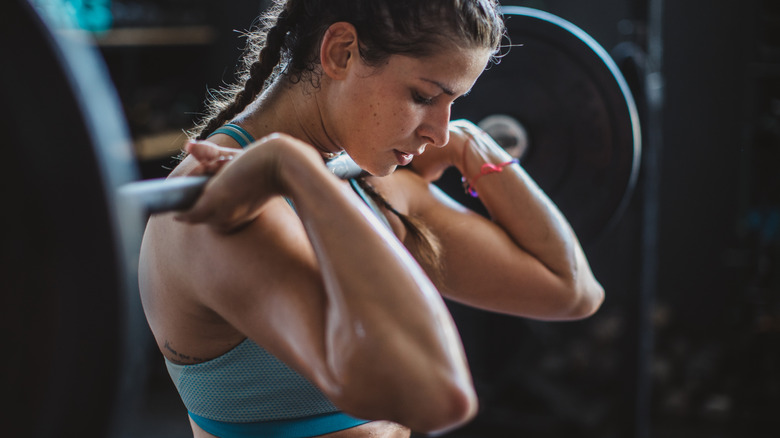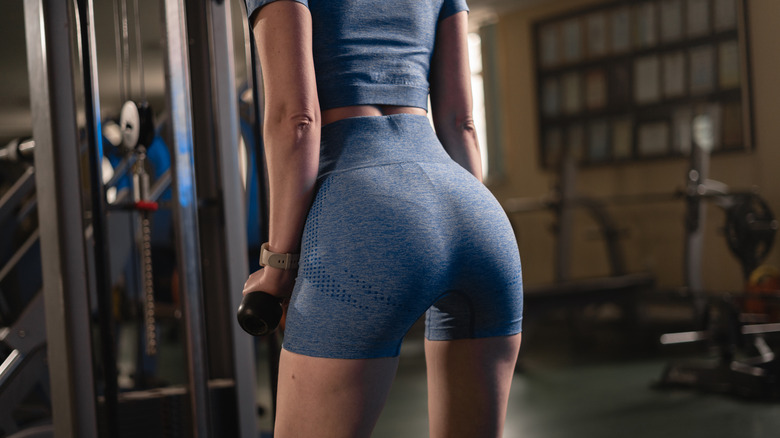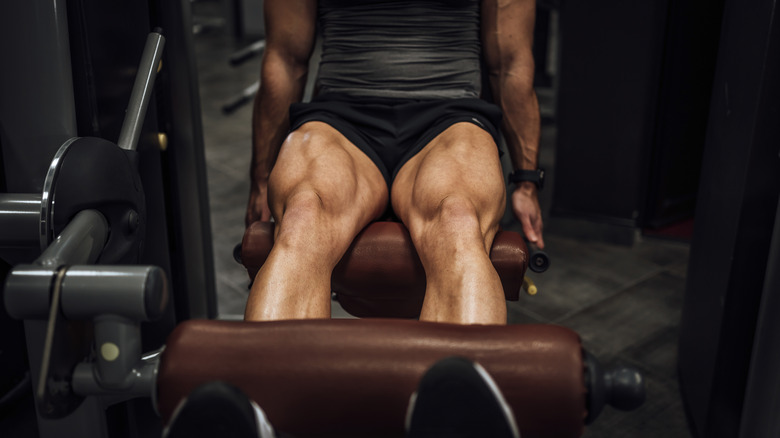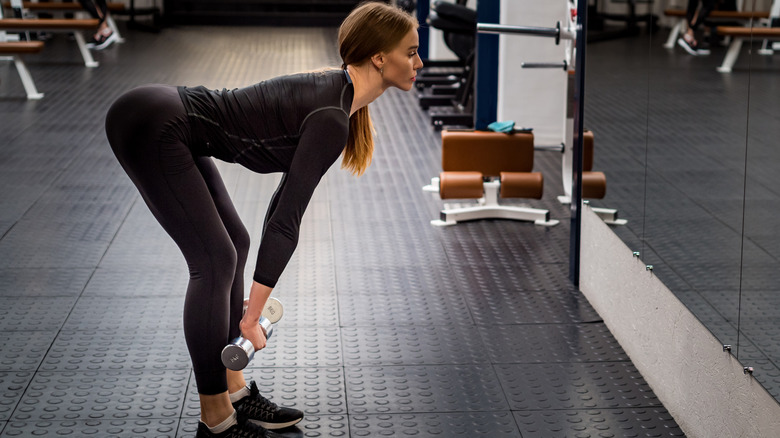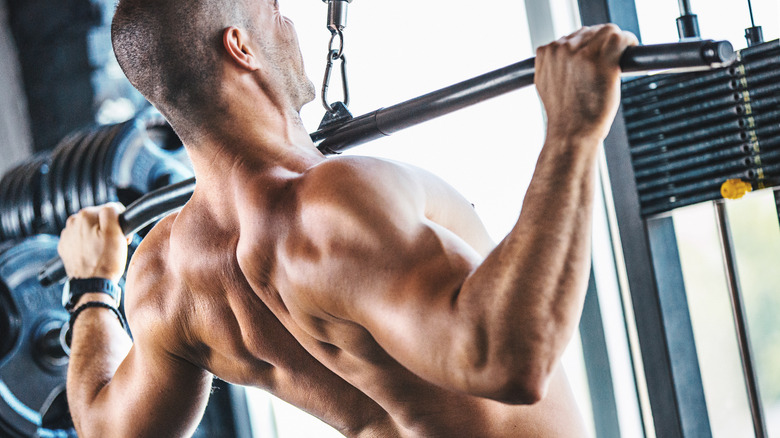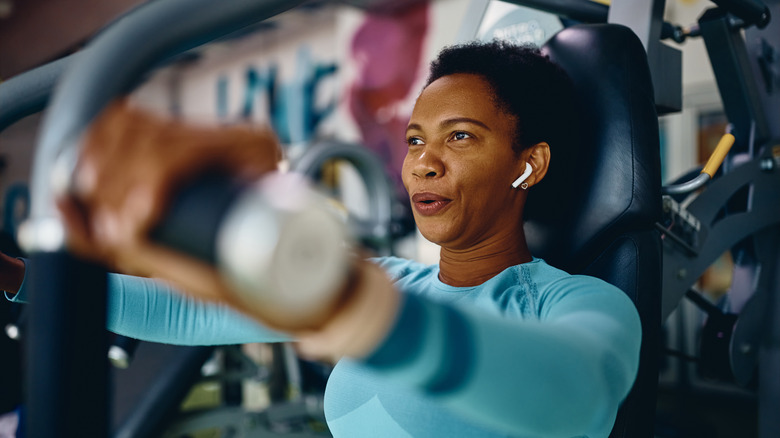These Muscles Burn The Most Amount Of Calories
You've probably seen many fitness and weight loss programs that promise bigger calorie burns in a shorter amount of time. You're told that exercising in the "fat-burning zone" for a longer duration burns a greater percentage of fat, but it can be frustrating to walk for an hour on the treadmill and only see a few hundred calories burned on your fitness tracker. Sure, those calories add up over a long time, but you want faster results.
On the other hand, you've probably learned that building muscle burns more calories. A pound of muscle burns 2.5 times more calories in a day than a pound of fat (per WebMD). So maybe you'll hop off the treadmill after an hour then do some tricep pushdowns on the cable machine to help tone your arms. Instead, you might consider working the bigger muscles. Why? The larger the muscle, the more energy (i.e. calories) needed to move them. Rather than doing tricep pushdowns, head for the free weight area. That's because the largest muscles in the body are the gluteus maximus, quads, lats, and hamstrings.
Gluteus maximus
As the largest muscle of your body, your glutes do much more than provide padding when you sit on a chair. The gluteus maximus provides power for your sprinting and climbing, but weak glutes from sitting all day can lead to lower back pain. You can do several isolation exercises to target your gluteus maximus, but compound movements such as a box squat will work your other larger muscles like your hamstrings and quadriceps. It's like getting multiple sets of these muscle groups. And guess what? Compound exercises burn more calories.
To do a box squat with proper form, sit down on a sturdy bench or box to get the proper distance of your feet to the box. The height of the bench should have your thighs parallel or a little lower. Your feet should be shoulder-width apart with your toes pointing slightly outward. Without using your hands, stand up. To descend into the squat, draw your hips back and bend your knees while maintaining a natural curve in your lower back. Your knees should be on the same train tracks as your feet so they don't pull inward or outward.
Keeping your weight in your heels, tap the box or bench gently with your glutes while maintaining the engagement of your core and leg muscles. On your way to standing, drive through your heels and extend through your hips to squeeze your glutes. Once you get used to the movement, you can add dumbbells or a barbell for added resistance.
Quadriceps
Your quadricep muscles are those thick muscles on the front of your thighs and serve to stabilize your knee. You feel your quads when you kick, run, and descend the stairs. Isolation exercises to strengthen the quadriceps are the leg extension machine, but another version of a squat can target your quads while strengthening your gluteus maximus, core, and upper body. The heel-elevated goblet squats are also more forgiving if you have limited ankle flexibility.
For this exercise, you'll need a dumbbell or kettlebell you can hold with both hands. Like a regular goblet squat, this weight will be held at your upper chest, so choose the right weight for you. Choose a weight plate or two to elevate your heels. You can also use a yoga block.
Stand with the weight at your chest and your feet at a comfortable distance and toes pointing straight or slightly outward. As you descend, the weight will try to pull you forward, but pull your hips slightly back. Be sure to keep your chest up so you're not hunching the weight over. Keep bending your knees, going as deep as you can. Your knees will move slightly past your toes. To come up, drive through the balls of your feet, keeping your arms, core, and upper chest stable. You might notice that you can go deeper into this squat than a regular squat, but you'll probably need a lighter weight.
Hamstrings
Your hamstrings are the antagonist muscles to your quads, and they work with your gluteal muscles to extend your hip. Strong hamstrings not only burn more calories, but they also help stabilize your knee by protecting your anterior cruciate ligament. To strengthen your hamstrings, you can turn to a weightlifter's favorite, the Romanian deadlift (RDL). The RDL will also blast your glutes and begin firing up your lats (more on those in a mo'), but you'll have to be careful about your lower back.
Unlike the regular deadlift, you'll start the RDL standing using an overhand grip to hold a barbell, dumbbells, or kettlebells at the top of your thighs. Your feet should be hip-width apart with your toes facing forward. Keep your eyes facing forward and pinch your shoulder blades together to keep your chest from dropping. Your back should have a slight arch, and imagine drawing your two hip points together to engage your core.
While keeping a micro bend in your knees, hinge your hips backward as you lower the weight until you feel a slight stretch in your hamstrings. As you hinge your hips to pull the weight back up, imagine trying to rip a paper towel between your feet to further engage the legs and glutes.
Latissimus dorsi
If you remember Chris Evans as Captain America, that V-taper comes from the latissimus dorsi muscles. These wing-shaped muscles on your back are the largest ones in your upper body. Strong latissimus dorsi muscles help stabilize your shoulders and support your torso during your squats and deadlifts. They'll also help you breathe better.
You could try pull-ups to build strong, calorie-burning latissimus dorsi, or you can opt for the lat pulldown machine found in many gyms. You could also do lat pulldowns using a resistance band tied to the hinge of a door. Sit at the lat pulldown machine facing the weight stack, and choose about 25% of your current weight as a warm-up. Most lat pulldown machines have a wide bar that's angled towards the end. If this is too wide for you, there should be other bars, but this will recruit other back muscles.
Using an overhand grip, pull the weight down until the bar reaches the top of your sternum. It's ok to lean back a little and look up so you're not compressing your chest. Your shoulder blades should be pinching towards one another, and pull your elbows back. Hold for a second, then control the weight as the bar reaches overhead again. To engage your lats, let the muscles pull the weight rather than using momentum.
Maximizing your calorie burn
Muscle not only burns more calories per pound than fat, but some pretty interesting processes occur in your body after a workout. Your muscles release a host of hormones and other substances into your bloodstream after a hard workout. This signals reactions within your cells during the repair process, and genes within your fat cells begin breaking down fat into fatty acids (per The New York Times).
You can maximize your calorie burn by minimizing your rest between sets. Long rests between sets can help you lift heavier weights, but shorter rest means you'll be spending more time working your muscles. If 30 seconds between 4 sets of squats sounds exhausting, you could do one set of squats and then one set of lat pulldowns to keep you moving. This might mean doing between 15 to 30 reps using a weight that's 40% to 60% of your maximum ability for each exercise.
You don't have to give up the treadmill or your favorite cardio if you want to burn calories. Combining cardio and weight training can boost your calorie burn even more. Just be sure to do your weight training first to ensure you have proper form (per MyFitnessPal).

